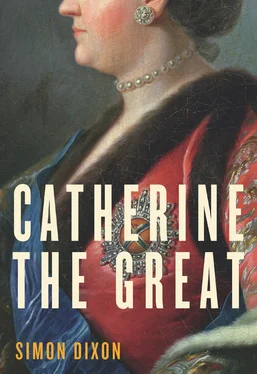The greatest legacy of Sophie’s early education was a form of secularised Pietist work ethic that stayed with her for the rest of her life. ‘I have always been able to concentrate hard,’ she boasted in 1785, regularly peppering her instructions to subordinates with exhortations not to waste time. ‘Waste as little time as possible,’ she urged her favourite, Peter Zavadovsky: ‘Time belongs not to me but to the empire.’ 26Crucial as this sense of duty was to become, the mature empress gave her childhood teachers no credit for it. On the contrary, as a celebrated patron of the Enlightenment and correspondent of Voltaire, she looked back on Stettin as an isolated provincial backwater. ‘Is it my fault that I do not share the taste of my century?’ she once asked Grimm, in mock defence of her alleged aesthetic shortcomings. ‘I think that Mlle Cardel and M. Wagner belonged to another age.’ 27
* * *
Frustrated by the constraints of Stettin’s narrow society, the vivacious Johanna Elisabeth escaped as often as she could, shuttling back and forth across the north German plain to visit better-connected relatives. At the age of three, Sophie accompanied her on the first of several trips to her maternal grandmother in Hamburg. Here, as she grew older, she would experience an exceptional degree of freedom: ‘I did what I wanted and ran about from morning until night in every corner of the house.’ On that first visit, however, the frightened child apparently had to be removed, screaming, from the opera house. ‘This scene left such an impression on me that I remember it even now,’ she wrote in 1771. 28Another frequent destination was the family seat at Zerbst, an insignificant town fifty miles south-west of Berlin and roughly equidistant between Magdeburg and Wittenberg, where Martin Luther had famously nailed his ninety-five theses to the door of the church in October 1517. Best of all, the ambitious Johanna Elisabeth liked Berlin, where they regularly spent part of the winter.
Zerbst and the Prussian capital, however, were primarily calling points en route to the Court of Brunswick-Wolfenbüttel in Lower Saxony, where Sophie’s mother had herself been raised and where her godmother, the dowager Duchess Elisabeth Sophie Marie of Brunswick-Lüneburg, had paid her dowry and arranged her marriage to Christian August at the palace at Vechelde, six miles west of Brunswick, in 1727. 29More at ease than her husband in the grande monde , Johanna Elisabeth willingly returned to spend several months of the year with her benefactress. For the growing Sophie, it proved to be a memorable experience: ‘I was cajoled and made much of, small as I was. I heard it said so often that I was clever, and that I was a big girl, that I fancied it must be true. I stayed up for all the masquerade-balls and festivals and went all over the place. I chattered like a magpie and was excessively forward.’ 30
There was much for an inquisitive child to see. The Court of Brunswick had been an important centre for the arts since the time of Shakespeare’s contemporary Duke Heinrich Julius, himself a notable playwright. Duke Anton Ulrich (r. 1685–1714) was an even more prolific Baroque novelist and poet, and it was during his reign that the built environment of the Court was transformed. That seasoned observer of European Court life, Baron Pöllnitz, particularly admired the duke’s homage to Versailles, his new country seat ( Lustschloss ) at Salzdahlum, a stone-clad timber palace halfway between Brunswick and Wolfenbüttel: ‘It has a great gallery with a collection of pictures by the chief painters which is not to be met with elsewhere.’ 31Salzdahlum’s architect Hermann Korb also designed a celebrated rotunda to house the Duke August Library at Wolfenbüttel—then, as now, one of Europe’s leading scholarly collections—of which no less a philosopher than Gottfried Wilhelm Leibniz was chief librarian between 1691 and 1716. 32The interior of the residence itself, one of the largest castles in northern Germany, was reshaped by the addition of a suite of Baroque staterooms. 33The long reign of Duke Karl I (r. 1735–80) proved to be a flourishing period for the arts during which Gotthold Lessing, the greatest literary figure of the German Enlightenment, took charge of the Duke August Library in the 1770s and the Court maintained both an Italian opera company and a French ballet. 34As a result of such lavish expenditure, Brunswick’s national debt rose from 1 million thalers in 1693 to 11 million in 1750, by which time Karl’s Court had more than doubled in size to around 400 people. 35Even so he never doubted the value of the splendour he created, and there was no sign of a decline in his dynasty’s fortunes at the time of Sophie’s visits.
Though the regal status achieved by their more powerful rivals in Dresden and Berlin proved beyond the reach of second-division German princes such as the dukes of Brunswick, there was no shortage of royalty to be found at their Court. Duke Karl’s sisters included not only Elisabeth Christine, who in 1733 had married the future Frederick the Great of Prussia (r. 1740–86), but also Sophie’s exact contemporary, Princess Juliana Maria, who corresponded with her in later life after becoming queen of Denmark. Among their brothers were Prince Ludwig of Brunswick, who became tutor to the Stadtholder of the Netherlands and Prince Ferdinand, subsequently a general in Prussian service. Sophie got to know them all. As she later recalled in a passage of her memoirs intended to show that she had by no means arrived in Russia as a naïve provincial:
The Court of Brunswick was then a truly regal one, judging by the quantity of fine houses it occupied and their decoration, by the good order that reigned at this Court, and by the number of people of various sorts whom it maintained, and by the crowd of foreigners who visited it continually, and the grandeur and magnificence that characterised every aspect of its life. Balls, operas, concerts, hunts, promenades, banquets followed one another every day. That was what I saw for three or four months of the year, every year between the ages of seven and fourteen. The Prussian Court was by no means so well regulated, nor did it seem as splendid as that of the Duke of Brunswick. 36
Petty German princes may have strained every sinew to emulate Versailles, but according to the French historian Adrien Fauchier-Magnan, writing shortly after the end of the Second World War, all they achieved was ‘a puerile, grimacing parody, an extravagant caricature of the luxury and elegance of the Roi Soleil ’. 37In this way of thinking, the best that could be expected of a German ruler was harmless eccentricity. In all too many cases, however, oddity seemed to border on insanity—‘Germany teems with princes and dukes,’ Count Manteufel observed in 1738, ‘three-quarters of whom are not right in the head’—so that the political landscape was dotted by a profusion of self-indulgent despots, each extorting taxes from his benighted subjects to fuel his obsession with personal glory. 38
Like all caricatures, this one incorporates a recognisable grain of truth. As Sophie was soon to discover, flagrant marital infidelity was a feature common to hothouse Court societies all over Europe. Though German Courts were no exception, there was no doubt about the identity of the monarch who had set new standards of shamelessness in his relationships with the opposite sex. When Duke Eberhard Ludwig of Württemberg scandalised his Lutheran officials in 1707 by declaring his intention to marry his paramour while his first wife was still alive, he countered their objections by pointing to the example of Louis XIV. 39Louis had sired a string of royal bastards—so-called ‘children of France’—by a succession of mistresses which ended only with his secret second marriage to Madame de Maintenon in 1683. Only then, as a recent biographer remarks, did the king undergo a ‘drastic conversion to monogamy’, coming to resemble ‘a reformed alcoholic who will not have a bottle in the house’. 40
Читать дальше












